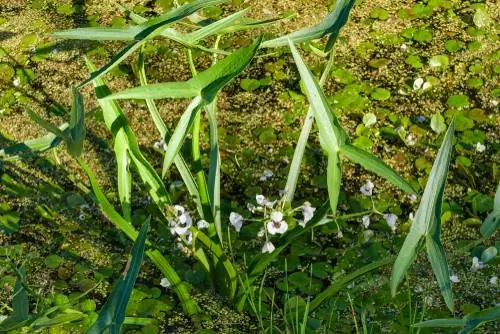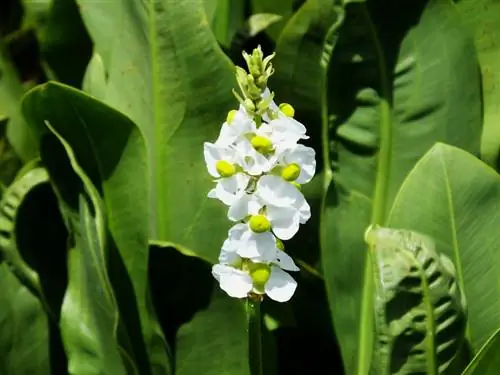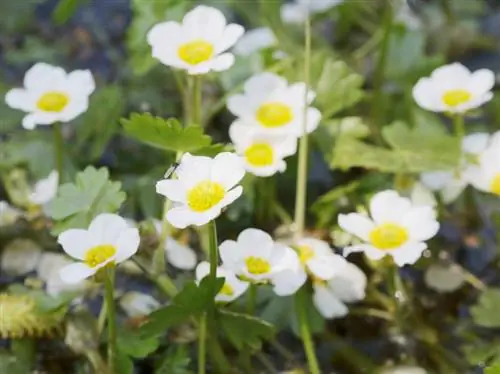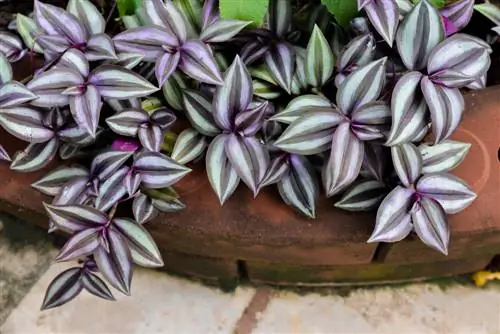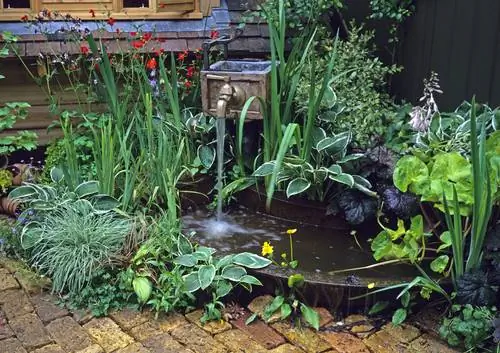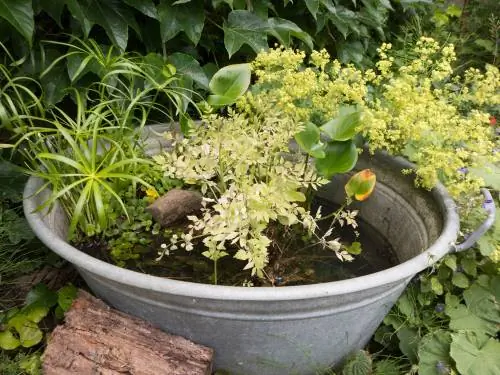- Author admin [email protected].
- Public 2023-12-16 16:46.
- Last modified 2025-01-23 11:21.
The native arrowhead (bot. Sagittaria sagittifolia), sometimes also called arrowleaf, is a popular aquatic and marsh bed plant. The perennial is particularly popular as a solitary plant in the shallow water zone of the garden pond or other artificial water system. The attractive species is considered easy to care for and reproduces quickly, and it can also be used very well as a natural filter.
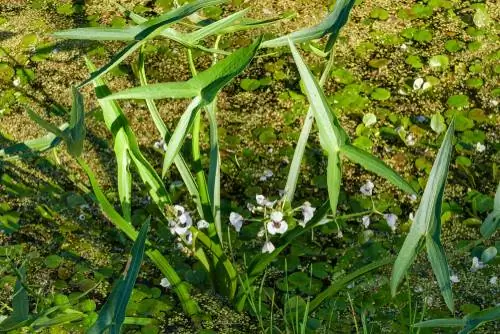
What's special about arrowhead?
Arrowweed (Sagittaria sagittifolia) is an easy-care, perennial aquatic plant that grows in the shallow water zone of garden ponds. It filters water naturally and produces attractive, arrow-shaped leaves and white flowers from June to August. Arrowhead is hardy and multiplies quickly.
Origin and distribution
Just like the various species of the related frog spoonwort, the common arrowhead (bot. Sagittaria sagittifolia) belongs to the frog spoon family (bot. Alismataceae). The species is particularly widespread in the stagnant to calmly flowing, limestone and nutrient-rich waters of the North German Plain, but also occurs in the rest of Central Europe up to the foothills of the Caucasus as well as in Siberia and as a neophyte even in North America. The perennial prefers flat regions and can no longer be found at altitudes above 500 meters.
Usage
The native and therefore hardy arrowhead is planted in the garden primarily as an easy-care ornamental plant in the shallow water zone of the garden pond and other shallow water areas. It is particularly valuable as a so-called reduction plant. These are plant species that filter the water in a completely natural way and therefore keep it he althy without chemical additives. Arrowhead can be planted both as a solitary plant and in small tuffs of a maximum of eight plants per square meter. There are also a number of suitable planting partners such as the loosestrife (bot. Lythrum), the dwarf cattail (bot. Typha minima) or the blue-green rush (bot. Juncus inflexus). Furthermore, the arrowweed also harmonizes very well with species such as the European sea jug (bot. (Nymphoides peltata) or various water lilies (bot. Nymphaea).
Appearance and growth
The perennial, perennial aquatic plant grows in clumps and forms numerous runners over time. Thanks to the strong leaves that grow above the water surface, the arrowhead reaches heights of between 30 and 50 centimeters, with the above-ground parts being pulled in before winter and the plant overwintering in the form of spherical tubers on the bottom of the water. It forms these overwintering tubers on its foothills.
If the plant is in a sunny location, it always aligns its leaves in a north-south direction. This behavior is intended to protect the leaves from the sun and you can also use it as a natural compass. For this reason, the arrowhead is sometimes referred to as the “compass plant”.
leaves
In principle, the arrowhead has three different types of leaves, each of which has a different shape. The floating leaves, for example, which are always under water, are band-shaped and are formed first. Only then do the first oval to broad leaves appear above the water surface. These are visually reminiscent of those of the related frog spoon. At the very end are the eponymous arrow-shaped leaves that make the species so distinctive. The leaves, which rise upright into the air, are long-stemmed and triangular. In autumn the summer green leaves turn yellow.
Flowers and flowering time
The white arrowhead flowers, which are only about two to four centimeters large, appear between June and August. They consist of three petals arranged in tiered whorls on long, triangular flower stalks and have a pink center. The female flowers are on the lower whorls, the larger male flowers on the upper ones. Pollination usually occurs by hoverflies, but also by other insects.
Fruits
After the flowering period, inconspicuous, small nut fruits develop. These contain only one winged seed each.
Toxicity
The common arrowhead is not poisonous. In fact, the tubers located at the base of the plant are even edible, which is why the species is cultivated for consumption primarily in China (as well as in other Asian countries). However, the starch-rich tubers, which taste reminiscent of potatoes, must be peeled after preparation because the peel contains many bitter substances. Arrowhead tubers are particularly often cooked and processed into flour, which is suitable for both cooking and baking.
Which location is suitable?
The adaptable and extremely robust arrowhead needs a sunny to partially shaded place on the bank of a stagnant to slowly flowing body of water such as a garden pond or a stream. Here it should be placed on the bank area to a maximum depth of 40 centimeters. The water should also have a high nutrient content so that the plant can thrive in it.
Floor
Ideal is a permanently wet, humus-rich and loamy-muddy subsoil in which you can plant the arrowhead at a water depth of between five and 30 centimeters. Due to the different leaves found both above and below the water surface, the species can cope quite well with fluctuating water levels.
Planting arrowweed correctly
When planting, place the arrowhead tubers directly in the shallow water area of the garden pond and cover them with gravel. In this way you prevent it from being washed away. For a group of plants, around six to eight specimens should be planted per square meter. For solitary planting and in smaller garden ponds, however, it is advisable to plant the tubers in special plant baskets (€1.00 on Amazon) in order to prevent them from spreading from the outset. The best time of year to plant this attractive aquatic plant is spring.
Watering and fertilizing
Care measures such as watering and fertilizing are not necessary for planted arrowheads as long as the nutrient content in the water is correct.
Cut arrowweed correctly
Cutting measures are also unnecessary. You should only fish off the parts of the plant that turn yellow in autumn from the water surface before winter, but you should not cut them off. The tubers draw the nutrients they need for new growth in spring from the stems and foliage, which is why removing them prematurely leads to a nutrient deficiency. As a result, the arrowhead no longer sprouts.
Propagate arrowweed
Sagittaria sagittifolia often has to be prevented from spreading excessively when it is planted, as the species is extremely prolific. Arrowhead propagates all by itself both through self-sowing and through its overwintering tubers, which develop on the numerous runners. You can also propagate the plant specifically by division, whereby you dig it up along with its rhizome and cut it into the desired number of sections. Each section should have at least one shoot and can then be used again at a new location. It is best to divide in spring, when there are signs of new growth anyway. You can also separate the overwintering tubers from the mother plant - also in spring - and plant them separately in a new place.
Wintering
Special winterization measures are not necessary as arrowhead is sufficiently hardy as a native plant. It pulls in its leaves in autumn and stores the nutrients they contain in the tubers, which form on the foothills over the summer and finally sink to the bottom of the water. In spring the plant sprouts new shoots from these tubers.
Diseases and pests
Basically, arrowhead is unproblematic when it comes to diseases and pests and is resistant to both. The only problem that can become problematic, especially on larger ponds, are hungry ducks, which also find the starchy tubers very tasty and eat entire populations practically overnight.
Tip
Not all types of arrowhead develop edible tubers. If you are interested in exotic vegetables, try the water nut (bot. Trapa natans). This also spreads over large areas of larger garden ponds. The species is sometimes incorrectly referred to as water chestnut, when in fact it is the species Eleocharis dulcis.
Species and varieties
Botanists distinguish around 40 different species of arrowweed, which are native to temperate to tropical regions of the world. Depending on their origin, the various arrowhead species can be used for planting artificially created bodies of water in the home garden or in aquariums. In contrast to the native arrow herbs, the varieties that come from tropical regions are not hardy. The genus (bot. Sagittaria) belongs to the plant family of the frog-spoon family (bot. Alismataceae).
Changing Arrowhead (bot. Sagittaria latifolia)
This species, which is native from Canada to Mexico, is also known as broad-leaved arrowhead and is now native to Europe as a neophyte. The hardy, upright growing perennial develops strikingly wide, arrow-shaped and shiny green leaves. It reaches heights of between 40 and 60 centimeters and shows pretty white, slightly pink flower panicles between June and August. The plant can be placed in water up to 40 centimeters deep and overwinteres with the help of its so-called overwintering tubers. But be careful: ducks love to eat these.
Grass-leaved Arrowhead (bot. Sagittaria graminea)
This species also comes from Canada and the USA and tolerates frost well. The medium green leaves of the perennial are lanceolate and narrower than those of the other arrowhead species. The plant grows to a height of up to 40 centimeters and can be cultivated in pots as well as on or in a garden pond or other artificially created body of water. The pretty, white flowers appear between June and September.
Flooding Arrowhead (bot. Sagittaria subulata)
This species, also known as small arrowhead, is native to the warm regions of the southern USA and West Java. The aquatic plant, which grows up to 60 centimeters high, is not hardy, but is a popular ornamental plant in aquariums. It is considered easy to care for and is therefore also suitable for beginners. In contrast to specimens planted in garden ponds and other bodies of water, you should fertilize arrowweeds cultivated in aquariums regularly - the plants have high nutrient requirements.

